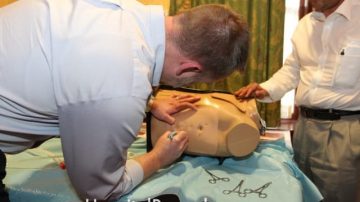Presently, the mortality of patients in the hospital with acute respiratory distress syndrome (ARDS) is higher than 40%. A sixteen month long observational study was conducted to determine if certain cutoff points of PaO2/FiO2 (less than or equal to 200…
Read MoreMore Articles – Cardiovascular diseases, Chest Tube, medical procedures, Needle Decompression, Respiratory diseases, Traumatology
A recent meta-analysis of 13 studies that were investigating needle decompression compared data of sample size, mean chest wall thickness, and decompression success rates. The meta-analysis concluded that the needle decompression catheter should be at least 6.5 cm in length…
Read MorePediatric lumbar punctures can have much higher success rates when proper positioning and technique are emphasized. The position should be the lateral decubitus position with hips flexed, but the neck does not need to be flexed. The spinal cord ends…
Read MoreRecently, a retrospective review of over 14,000 adult patients who underwent general anesthesia were assessed. A multivariable analysis was used to determine risk factors of difficult laryngeal mask airways (LMA). The following four risk factors were identified: male gender, age…
Read MorePrevious trials have investigated the use of B-type natriuretic peptide (BNP) to assess patients with dyspnea in the ED. The sentinel trial was the BNP (Breathe Not Properly) trial that evaluated nearly 800 patients presenting to the ED with complaints…
Read MoreA study was executed to decipher the best cut-off point for a positive Allen’s test. Ninety-three hands of 47 patients undergoing coronary artery bypass surgery were screened. The average age of the patients was 63.3 years. Independent observers examined these…
Read MoreTarget Audience: Emergency clinicians Background: A multidisciplinary group of emergency physicians, radiologists, cardiologists, and others has developed appropriateness criteria for the use of imaging to help inform clinicians for four clinical scenarios presenting as chest pain in the ED. Key…
Read MoreEvery four years the American College of Chest Physicians (ACCP) disseminates a new set of guidelines on the evaluation and management of venous thromboembolic disease (VTE). The ACCP just released its updated guidelines for the treatment of VTE and I…
Read MoreA prospective cohort single center study was conducted to analyze the risk associated with patients undergoing thoracentesis or small-bore chest tube placement while taking clopidogrel. Twenty-five patients taking clopidogrel gave consent to remain on the antiplatelet medication while undergoing thoracentesis…
Read MorePrior to the revised Swedish lumbar puncture guideline, a CT scan was often performed prior to lumbar puncture when acute bacterial meningitis was suspected. Taking the time to perform a CT scan of the head before lumbar puncture delays treatment…
Read MoreMore Articles – Arterial line, Cardiovascular diseases, Chest Tube, Emergency Procedures, Hematology, Medical General, medical procedures
These guidelines are for physicians who care for patients with return of spontaneous circulation (ROSC) after cardiac arrest, including emergency physicians, critical care physicians, and cardiologists These guidelines update the 2010 International Liaison Committee on Resuscitation guidelines for patients with…
Read MoreA systematic review found no significant missed injuries in obtunded blunt trauma patients who had normal CT imaging of their cervical spines. Given the significant morbidity and mortality associated with missed traumatic cervical spine injuries, patients in whom a reliable…
Read MoreMore Articles – Arterial line, Cardiovascular diseases, Central line, Infections, medical procedures
Arterial line-associated bloodstream infections occur at rate of 0.9-3.4 infections per thousand catheter-days. This rate of infections is similar to the risk of central line-associated bloodstream infections (CLABSIs). The CDC guidelines for arterial line placement recommend the use of chlorhexidine…
Read MoreThe goal of zero device-related infections is what CMS desires for all hospitals, but is not a realistic goal. Nevertheless, we can do everything in our power to minimize central line-associated bloodstream infections (CLABSIs). We now can appreciate that the…
Read MoreThe ACP CPG on the evaluation of patients with a suspected acute PE has the following primary recommendations: Use a validated clinical prediction rule to estimate pretest probability in patients with a possible acute PE (options include the Wells criteria…
Read MoreCategories
- ACLS (1)
- Arterial line (33)
- Cardiovascular diseases (77)
- Central line (55)
- Chest Tube (39)
- Dermatology (4)
- Emergency Procedures (139)
- Endocrinology (6)
- Endotracheal Intubation (36)
- Events (24)
- FAST Exam (12)
- Featured (113)
- Featured Procedure (42)
- Gastrointestinal diseases (32)
- Ginecology (3)
- Glidescope Intubation (21)
- Hematology (33)
- Hospital Procedures (85)
- Infections (32)
- Intraosseous line (8)
- King Tube (27)
- Laryngeal Mask Airway (18)
- Lumbar Puncture (36)
- Mechanical Ventilation (34)
- Medical General (95)
- medical procedures (258)
- Needle Decompression (6)
- Nephrology (11)
- Neurological diseases (12)
- Oncology (4)
- Paracentesis (32)
- Pericardiocentesis (3)
- Procedural Sedation (19)
- Respiratory diseases (85)
- RUSH Exam (8)
- Thoracentesis (37)
- Traumatology (24)
- Travel (27)
- Ultrasound-Guided Peripheral IV (13)















